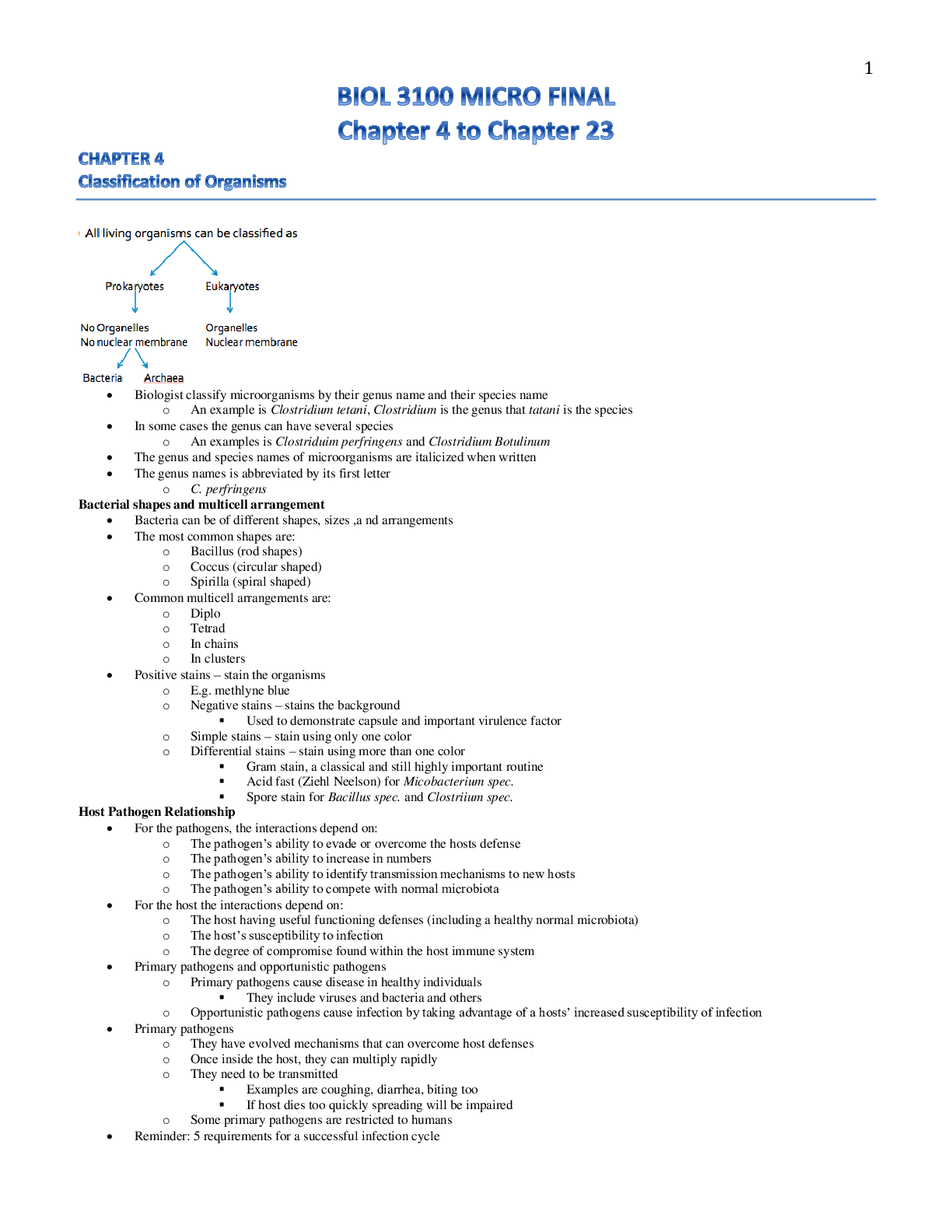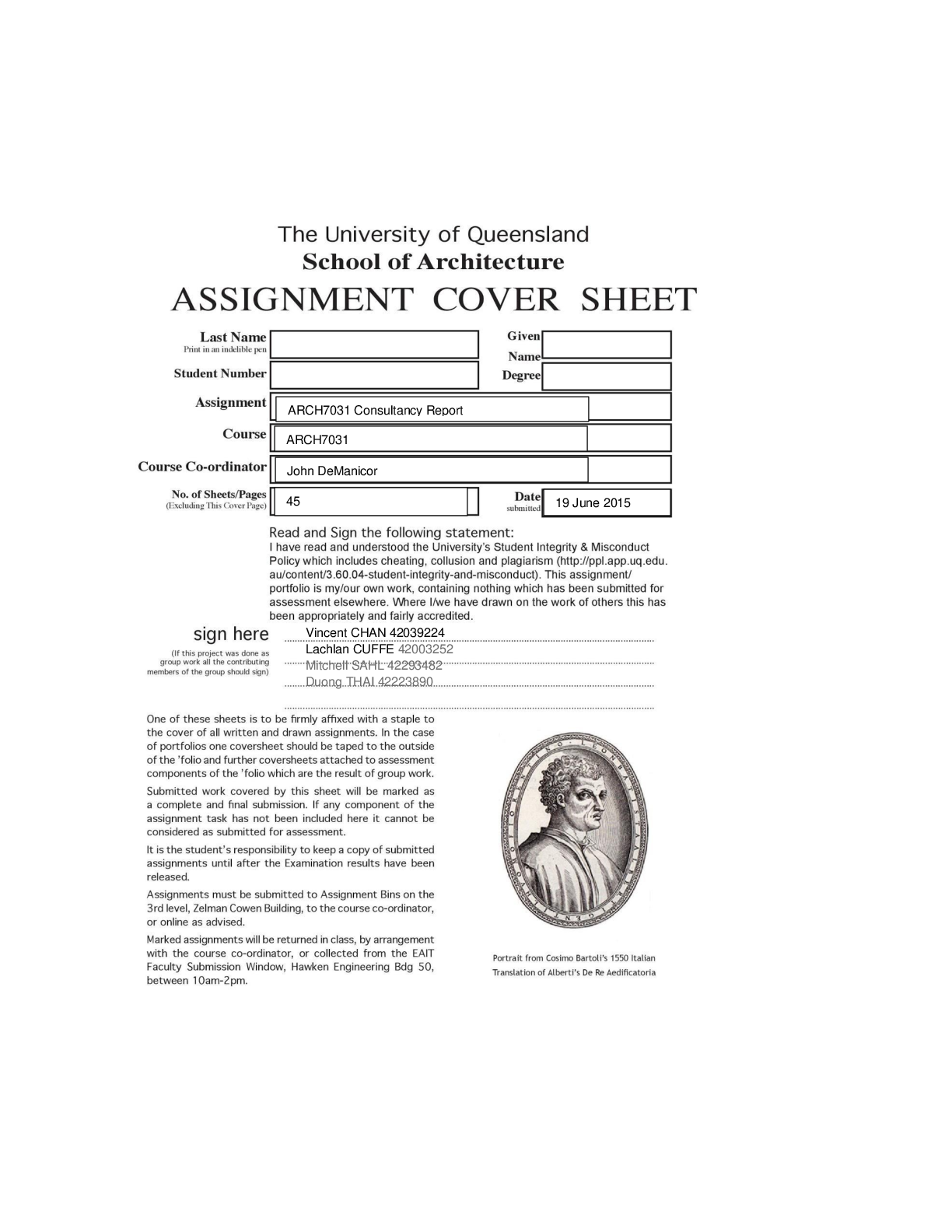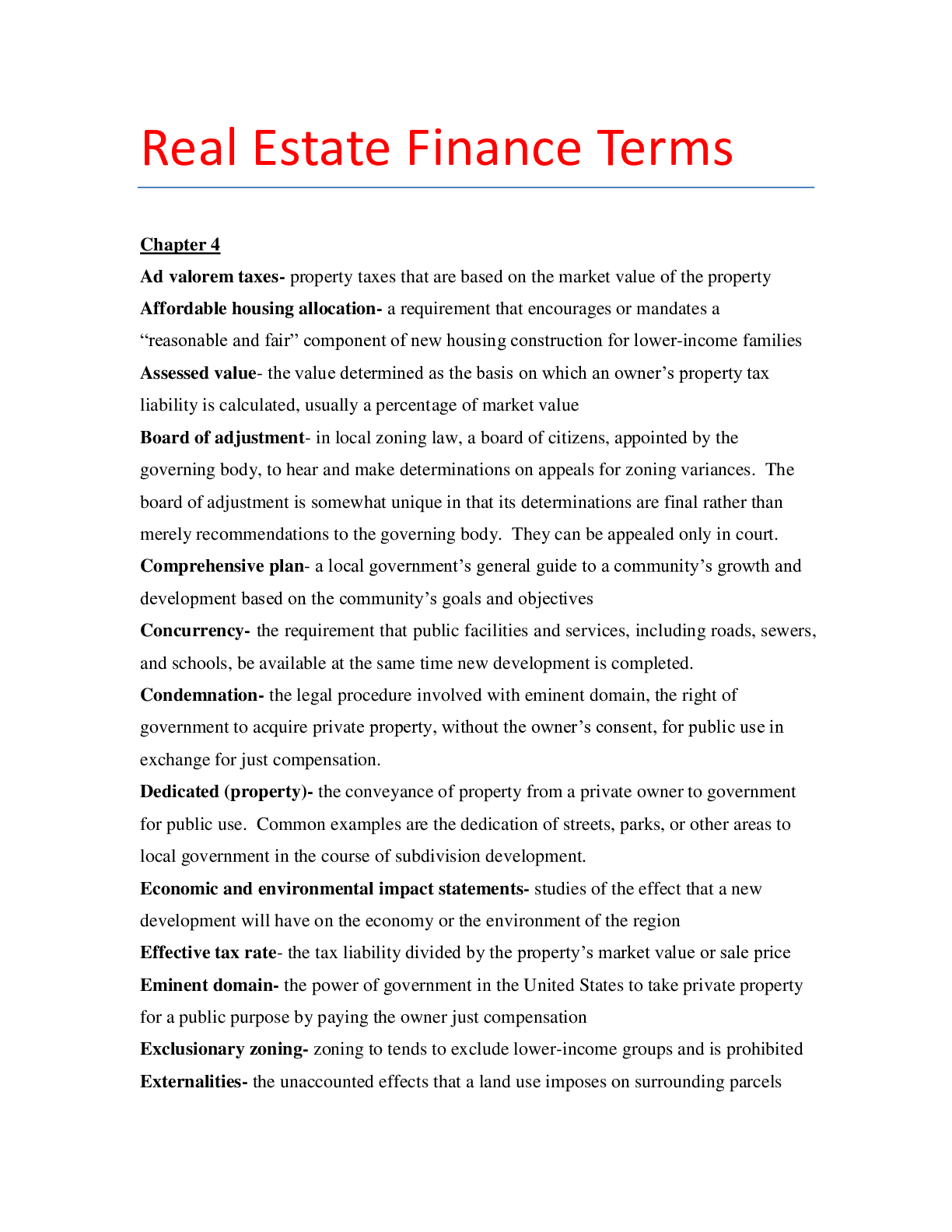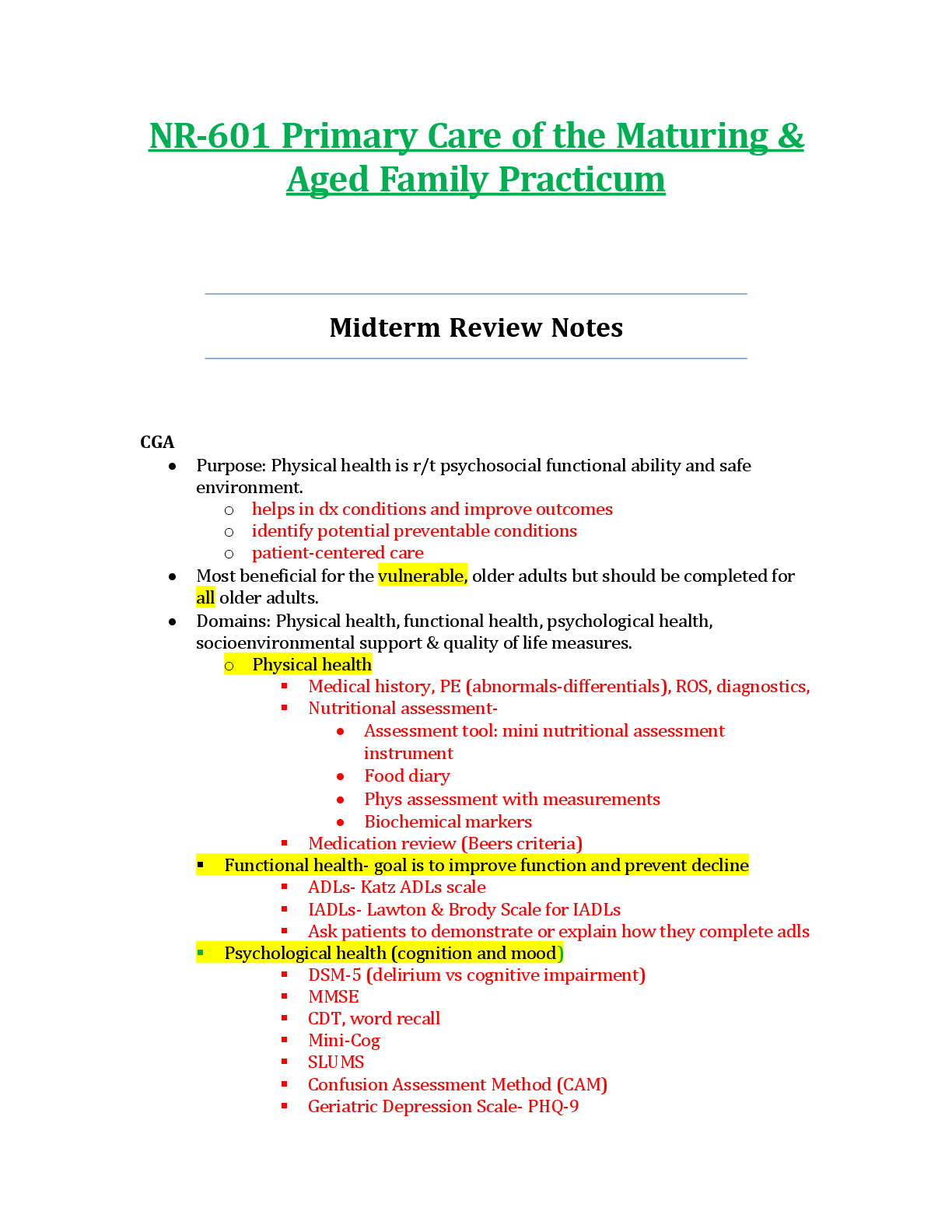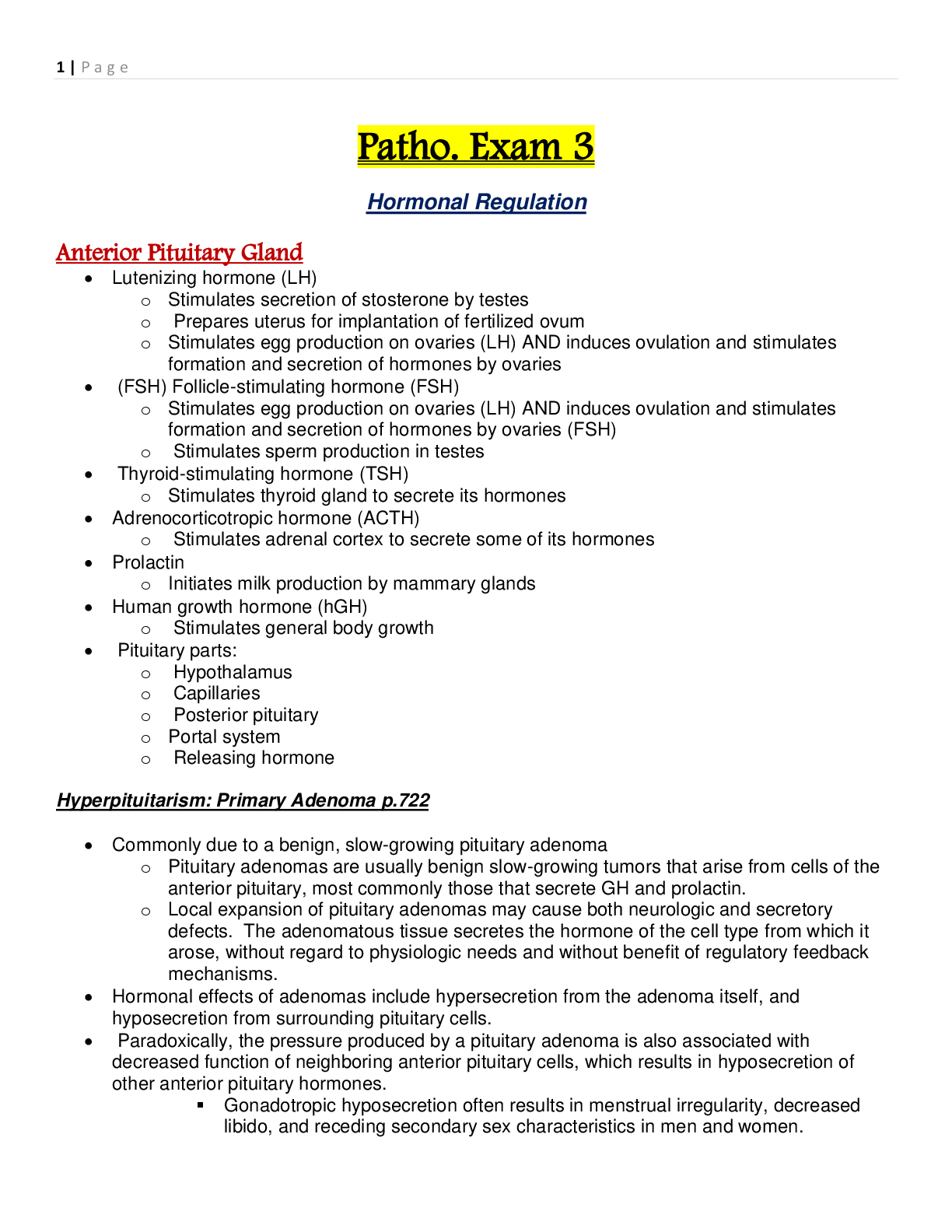Mathematics > Study Notes > CHAPTER 7: Exponential and Logarithmic Functions. The most elaborate and helful and easy to read lay (All)
CHAPTER 7: Exponential and Logarithmic Functions. The most elaborate and helful and easy to read layout and solutions on Exponential and Logarithmic Functions.
Document Content and Description Below
Exponential and Logarithmic Functions 7A Exponential Functions and Logarithms 7-1 Exponential Functions, Growth, and Decay Lab Explore Inverses of Functions 7-2 Inverses of Relations and Fun ... ctions 7-3 Logarithmic Functions 7-4 Properties of Logarithms 7B Applying Exponential and Logarithmic Functions 7-5 Exponential and Logarithmic Equations and Inequalities Lab Explore the Rule of 72 7-6 The Natural Base, e 7-7 Transforming Exponential and Logarithmic Functions 7-8 Curve Fitting with Exponential and Logarithmic Models Vocabulary Match each term on the left with a definition on the right. 1. exponent 2. function 3. relation 4. variable A. a symbol used to represent one or more numbers B. the set of counting numbers and their opposites C. a relation with at most one y-value for each x-value D. the number of times the base of a power is used as a factor E. a set of ordered pairs Simple Interest Use the simple interest formula, I = Prt, where I is the interest, P is the initial amount (the principal), and r is the interest rate for Problems 13–15. 13. Find the simple interest on an investment of $3000 at 3% for 2 years. 14. A savings account of $2000 earned $90 simple interest in 3 years. Find the interest rate. 15. Jeri got a loan at 6% simple interest for 3 years. She paid back a total of $5310. How much was the loan? 20. Copy the graph, and use the line of symmetry to complete the figure. Scientific Notation Write in scientific notation. 21. 7,000,000,000 22. 0.0000000093 23. 16.75 Write in standard notation. Previously, you • used the properties of exponents to simplify expressions. • performed inverse operations. • solved problems involving linear, quadratic, and polynomial functions. You will study • exponential functions. • logarithms, the inverse of exponents, and logarithmic functions. • solving problems involving exponents and logarithms. Vocabulary Connections To become familiar with some of the vocabulary terms in the chapter, consider the following. You may refer to the chapter, the glossary, or a dictionary if you like. 1. You can think of the base as carrying its exponent. Which number in 103 = 1000 is the base? 2. A logarithm is an exponent. The base for common logarithms is 10. What would you think would be the common logarithm of 1000? 3. Where would you expect to find the variable x in an exponential equation ? 4. Multiplication and division are inverse functions. What would you expect an inverse function to do to its corresponding function? 5. The base of a natural logarithm is the number e. What are other constant values that are often named by a letter or symbol? 6. The Greek word asympto¯ tos means “not meeting.” How do you think a line on a graph called an asymptote would relate to a curve on a graph? When studying a difficult mathematical concept, rewrite the concept using your own words so that you can better comprehend the material. You may also find it helpful to provide your own example. The degree of a polynomial is given by the term with the greatest degree. A polynomial with one variable is in standard form when its terms are written in descending order by degree. So, in standard form, the degree of the first term indicates the degree of the polynomial, and the leading coefficient is the coefficient of the first term. INCLUDE an example to connect the words and the mathematics. Try This Read the following paragraph from Lesson 6-5, and rewrite it using your own words. The Irrational Root Theorem states that irrational roots come in conjugate pairs. For example, if you know that 1 + √2 is a root of x3 - x2 - 3x - 1 = 0, then you know that 1 - √2 is also a root. Recall that the real numbers are made up of the rational and the irrational numbers. You can use the Rational Root Theorem and the Irrational Root Theorem together to find all of the real roots of P(x) = 0. Exponential and Logarithmic Functions 489 Exponential Functions, Growth, and Decay */ AIA22-..546a..14 ACGanrararplyyhzoeu,xtdpaeospncreornicbtieeadlauanrneddtsolkoegtacarhpithgmreaxipcphofsunnoecfntetiioxanpl sofu.nnecnttiioanl sfu. nctions by examining intercepts, zeros, domain and range, and asymptotic and end behavior. Objective Write and evaluate exponential expressions to model growth and decay situations. Vocabulary exponential function base asymptote exponential growth exponential decay Moore’s law, a rule used in the computer industry, states that the number of transistors per integrated circuit (the processing power) doubles every year. Beginning in the early days of integrated circuits, the growth in capacity may be approximated by this table. Transistors per Integrated Chip Growth that doubles every year can be modeled by using a function with a variable as an exponent. This function is known as an exponential function. The parent exponential function is f (x) = bx, where the base b is a constant and the exponent x is the independent variable. The graph of the parent function f (x) = 2x is⎧shown. ⎫The domain is all real numbers and the range is ⎨ y⎥ y > 0⎬. Notice that as the x-values decrease, the graph of the function gets closer and closer to the x-axis. The function never reaches the x- axis because the value of 2x cannot be zero. In this case, the x-axis is an asymptote. An asymptote is a line that a graphed function approaches as the value of x gets very large or very small. A function of the form f (x) = abx, with a > 0 and b > 1, is an exponential growth function, which increases as x increases. When 0 < b < 1, the function is called an exponential decay function, which decreases as x increases. Tell whether the function p(x) = 5(1.2x) shows growth or decay. Then graph. You can model growth or decay by a constant percent increase or decrease with the following formula: In the formula, the base of the exponential expression, 1 + r, is called the growth factor. Similarly, 1 - r is the decay factor. nomics Application Tony purchased a rare 1959 Gibson Les Paul guitar in 2000 for $12,000. Experts estimate that its value will increase by 14% per year. Use a graph to find when the value of the guitar will be $60,000. Step 1 Write a function to model the growth in value for this guitar. f (t) = a(1 + r)t Exponential growth function = 12,000(1 + 0.14)t Substitute 12,000 for a and 0.14 for r. = 12,000(1.14)t Step 2 Graph the function. When graphing exponential functions in an appropriate domain, you may need to adjust the range a few times to show the key points. Step 3 Use the graph to predict when the value of the guitar will reach $60,000. Use the feature to find the t-value where f (t) ≈ 60,000. The function value is approximately 60,000 when t ≈ 12.29. The guitar will be worth $60,000 about 12.29 years after it is purchased, or sometime in 2012. 2. In 1981, the Australian humpback whale population was 350 and has increased at a rate of about 14% each year since then. Write a function to model population growth. Use a graph to predict when the population will reach 20,000. 3. A motor scooter purchased for $1000 depreciates at an annual rate of 15%. Write an exponential function, and graph the function. Use the graph to predict when the value will fall below $100. GUIDED PRACTICE 1. Vocabulary When the base in an exponential function is between 0 and 1, the function shows −−?− . (exponential growth or exponential decay) Tell whether the function shows growth or decay. Then graph. p. 492 5. Biology An acidophilus culture containing 150 bacteria doubles in population every hour. Predict the number of bacteria after 12 hours. a. Write a function representing the bacteria population for every hour that passes. b. Graph the function. c. Use the graph to predict the number of bacteria after 12 hours. 6. Physics A new softball dropped onto a hard surface from a height of 25 inches rebounds to about 2 the height on each successive bounce. a. Write a function representing the rebound height for each bounce. b. Graph the function. c. After how many bounces would a new softball rebound less than 1 inch? PRACTICE AND PROBLEM SOLVING Tell whether the function shows growth or decay. Then graph. 10. Railroads The amount of freight transported by rail in the United States was about 580 billion ton-miles in 1960 and has been increasing at a rate of 2.32% per year since then. a. Write a function representing the amount of freight, in billions of ton-miles, transported annually (1960 = year 0). b. Graph the function. c. In what year would you predict that the number of ton-miles would have exceeded or would exceed 1 trillion (1000 billion)? 11. Medicine A quantity of insulin used to regulate sugar in the bloodstream breaks down by about 5% each minute. A body-weight adjusted dose is generally 10 units. a. Write a function representing the amount of the dose that remains. b. Use a calculator to graph the function. c. About how much insulin remains after 10 minutes? d. About how long does it take for half of the dose to remain? Explain whether each function is exponential. 12. f (x) = 2x10 13. f (x) = 0x 14. f (x) = 1 • 0.5x 15. History In 1626, the Dutch bought Manhattan Island, now part of New York City, for $24 worth of merchandise. Suppose that, instead, $24 had been invested in an account that paid 3.5% interest each year. Find the balance in 2008. 16. Technology The quantity of new information stored electronically in 2002 was about 5 exabytes, or 5 × 1018 bytes. Researchers estimate that this is double what was stored in 1999. Suppose this trend continues. Write and graph a function to predict the pattern of growth beginning in 1999. 17. Business On federal income tax returns, self-employed people can depreciate the value of business equipment. Suppose a computer valued at $2765 depreciates at a rate of 30% per year. Estimate the number of years it will take for the computer’s value to be less than $350. Complete the table for each function. Round each value to the nearest hundredth. 21. Collectibles At the peak of a beanbag animal fad, one sales representative sold 12,000 of the animals in one month. Each month after that, the rep sold about 20% fewer animals. a. About how many beanbag animals did the rep sell in the 6th month after the peak? b. In which month did the rep first sell fewer than 1000 animals? 22. Banking The compound interest formula is A = P (1 + r )nt, where A is the amount earned, P is the principal, r is the annual interest rate, t is the time in years, and n is the number of compounding periods per year. Harry invested $5000 at 5% interest compounded quarterly (4 times per year). a. How much will the investment be worth after 5 years? b. When will the investment be worth more than $10,000? c. What if…? Harry could have invested the same amount in an account that paid 5% interest compounded monthly (12 times per year). How much more would his investment have been worth after 5 years? 23. Critical Thinking What are the coordinates of the point that is common to the graph of f (x) = ( 2)x and the graph of f (x) = ( 3)x? Find the range of each function for the domain (0, 10⎤⎦. 4 27. Geology Radon-222 is a gas that escapes from rocks and soil. It can accumulate in buildings and can be dangerous for people who breathe it. Radon-222 decays to polonium and eventually to lead. a. Find the percent decrease in the amount of radon-222 each day. b. Write an exponential decay function for the amount of a 500 mg sample of radon-222 remaining after t days. c. How much of the radon-222 sample would remain after 14 days? 28. Estimation According to the Population Reference Bureau, the world population in 2000 was 6.1 billion and increasing at an annual rate of 1.4%. Estimate the world population in 2020. Then write and evaluate an exponential function to predict the actual population, and compare it to your estimate. 29. Critical Thinking Which grows faster as x increases, x3 or 3x? Explain. 30. Write About It Describe a situation that could be modeled by an exponential function. Give the function and describe the meanings of several function values. 33. Short Response What are the values of a and b in f(x) = abx for the graph shown? 34. The population of a town was 89,443 in 1990 and has increased at a rate of 0.6% per year since then. Which function represents the town’s population t years after 1990? 89,443(1.6)t 89,443(1.06)t 89,443(1.006)t 89,443(1.0006)t CHALLENGE AND EXTEND 35. Critical Thinking Recall that polynomials are classified by degree. Why doesn’t an exponential function have a degree? Solve by graphing. Write the answer to the nearest hundredth. 39. Compare the graphs of y = 2x and y = x2, where -10 < x < 10. How many points of intersection are there? Give the coordinates of these points. 40. Biology Researchers found that the number of mosquitoes per acre of wetland after a frost is about 10 to the power 1d + 2, where d is the number of days since the frost. How many mosquitoes per acre are there at the time of the frost? How long after the frost does it take for the population to quadruple? 41. In f (x) = bx, why is the domain of b restricted (b > 0, b ≠ 1) for exponential functions? SPIRAL REVIEW Graph each function with a graphing calculator. Identify the domain and range of the function, and describe the transformation from its parent function. (Lesson 1-9) 42. f (x) = √˙x -˙˙3 43. f (x) = -x2 + 1 44. f (x) = 2x3 45. f (x) = x - 4 46. Entertainment Fred and Katrina are buying video games. Fred bought 3 new video games and 2 old video games for $235. Katrina bought 1 new video game and 4 old video games for $195. Find the cost of each type of video game. (Lesson 3-2) Identify whether the function graphed has an odd or even degree and a positive or negative leading coefficient. (Lesson 6-7) Use with Lesson 7-2 Explore Inverses of Functions You can use a graphing calculator to explore inverse functions and their relationship to the linear parent function f (x) = x. Graph the function f (x) = 2x and its inverse. Graph the function f (x) = 2x and the linear parent f (x) = x in the decimal window. Enter the functions, and then press and select 4 : ZDecimal. Use the DrawInv feature to graph the inverse of Y1. Enter the DRAW menu by pressing . Then select 8 : DrawInv. To select Y1, press . Use the arrow keys to move to the Y-VARS submenu. Select 1 : Function, and then select 1 :Y1 and press . The graph shows the original function f (x) = 2x, its inverse, and the linear parent f (x) = x. Notice that the inverse appears to be a function. Its domain is {x | x > 0}, and its range is Graph f (x) = x2, its inverse, and f (x) = x. 1. Compare the domain and range of f (x) = x 2 with the domain and range of its inverse. Is the inverse of f (x) = x 2 a function? Explain why or why not. Graph f (x) = x 3, its inverse, and f (x) = x. 2. Compare the domain and range of f (x) = x 3 with the domain and range of its inverse. Is the inverse of f (x) = x 3 a function? Explain why or why not. 3. Make a Conjecture Make a conjecture about the relationship between the domain and range of a function and its inverse. 4. Make a Conjecture Make a conjecture about the relationship of a function and its inverse to the line f (x) = x. The multiplicative inverse of 5 is 1 . The multiplicative inverse matrix of A = ⎡3 1⎤ is A-1 = ⎡ 1 You can also find and apply inverses to relations and functions. To graph the inverse relation , you can reflect each point across the line y = x. This is equivalent to switching the x- and y-values in each ordered pair of the relati 1. Graph the relation and connect the points. Then graph the inverse. Identify the domain and range of each relation. When the relation is also a function, you can write the inverse of the function f (x) as f -1(x). This notation does not indicate a reciprocal. Functions that undo each other are inverse functions. To find the inverse function, use the inverse operation. In the example above, 6 is added to x in f (x), so 6 is subtracted to find f -1(x). Use inverse operations to write the inverse of each function. Undo operations in the opposite order of the order of operations. You can also find the inverse function by writing the original function with x and y switched and then solving for y. 4. Graph f (x) = _2 x + 2. Then write the inverse and graph. 3 Any time you need to undo an operation or work backward from a result to the original input, you can apply inverse functions. Retailing Application A clerk needs to price a digital camera returned by a customer. The customer paid a total of $103.14, which included a gift-wrapping charge of $3 and 8% sales tax. What price should the clerk mark on the tag? 5. To make tea, use 1 teaspoon of tea per ounce of water plus a teaspoon for the pot. Use the inverse to find the number of ounces of water needed if 7 teaspoons of tea are used. GUIDED PRACTICE 1. Vocabulary When switching x and y, the result is always an inverse −−?− . (relation or function) Graph the relation and connect the points. Then graph the inverse. Identify the domain and range of each relation. 2. 3. [Show More]
Last updated: 3 years ago
Preview 1 out of 70 pages
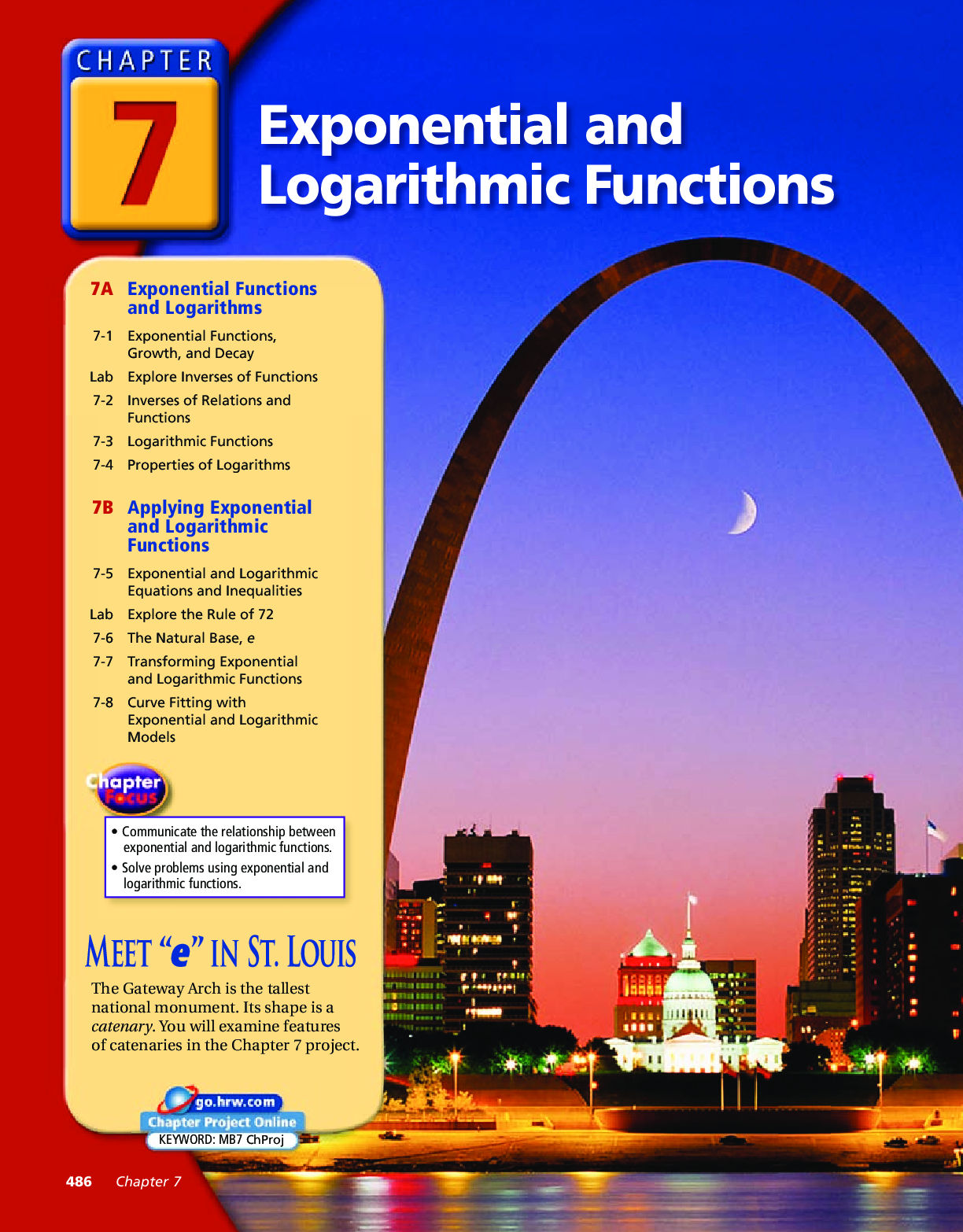
Buy this document to get the full access instantly
Instant Download Access after purchase
Buy NowInstant download
We Accept:

Reviews( 0 )
$9.50
Can't find what you want? Try our AI powered Search
Document information
Connected school, study & course
About the document
Uploaded On
Aug 30, 2020
Number of pages
70
Written in
All
Additional information
This document has been written for:
Uploaded
Aug 30, 2020
Downloads
0
Views
251

.png)
